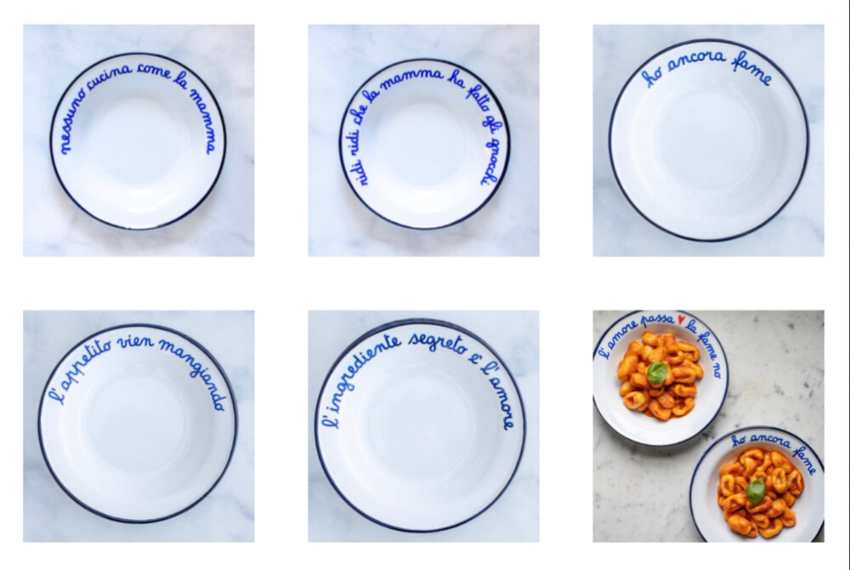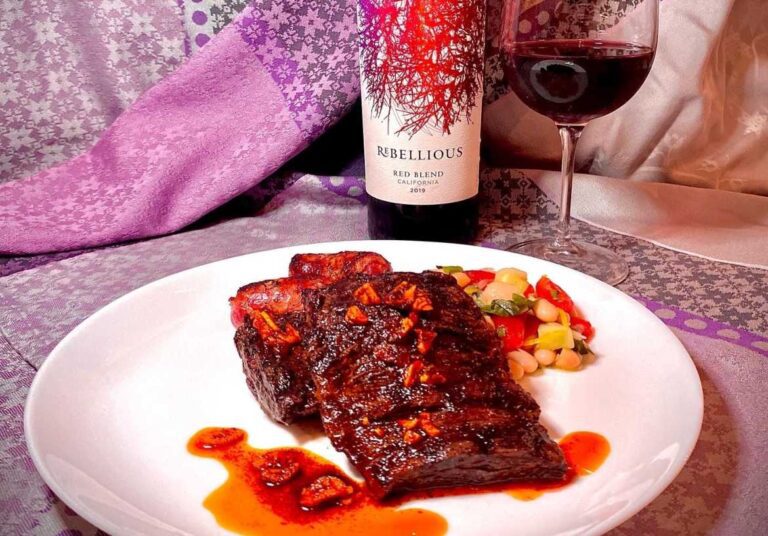Who doesn’t love Italian food and wine? One of my favorite memories from childhood was spending time in my nonna’s cucina. Adorned in a colorful apron, she was like the conductor of an orchestra, bringing to life a musical score of fresh and flavorful ingredients. The heady scents of meat browning, onions and garlic roasting, pasta boiling, and a rich tomato gravy simmering on the stove would make anyone who stopped by drop all their plans to stay in nonna’s Italian kitchen until the tiramisu and grappa were on the table.
I decided to recreate my own slice of Italian kitchen heaven—cucina di nonna—with a homemade pasta sauce served in delightful ceramic phrase bowls paired with an Italian wine.
Pasta “as needed” is never enough
Q.b. cucina gives everyday cooks the tools they need to create their own Italian feasts. The website features a wide selection of artisan kitchenware that is “rooted in tradition for the modern kitchen.” You’ll find a stunning collection of kitchen supplies, from hand-stamped linen napkins to gorgeous pasta cutters fitted with brass wheels. There are even a few items for use outside the kitchen, like colorful marbled stationary sets made in Florence. You can also find recipes, including those for pasta, meat, and desserts, as well as cooking tips such as the best way to salt pasta water and how to store fresh pasta.
Why q.b.? It stands for quanto basta, meaning “as much as needed,” and is commonly used in Italian recipes to indicate that there is no set amount of an ingredient in a recipe. Salt for example, is up to you to decide. Any cook worth her salt (pun intended!) knows that certain ingredients need to be added the q.b. way. And quanto basta sounds much better than the English “to taste,” don’t you think?

When my Italian phrase enamel bowls arrived, I used them to serve a flavorful pasta con i fagioli (with beans). The lightweight bowls are hand painted with a choice of six different fun Italian expressions. “This collection is affectionately known as A Pranzo dalla Nonna, “Lunch at Nonna’s,” it says on the website, “because that’s exactly how your grandmother would dish out multiple servings of fresh handmade pasta during a big Sunday lunch.”
Recipe for Rosemary Pasta With Beans, Tomatoes, Artichokes and Eggplant

This perfect and healthy dish couldn’t be simpler to make! The rosemary adds a nice punch of woodsy aromatics.
In a medium-sized saucepan, heat one tablespoon of extra virgin olive oil, 2 teaspoons chopped garlic, and ¼ teaspoon red pepper flakes and sauté over low heat for a minute. Mix in a 25-ounce can of whole peeled tomatoes, 2 teaspoons chopped rosemary, 1/2 teaspoon salt, and a few grinds of fresh pepper and let the mixture simmer for about 20 minutes.
During the last 8 minutes of cooking, add one 15.5-ounce can of kidney beans and a cup of artichoke hearts (I happened to have Trader Joe’s frozen artichoke hearts in my freezer). If you have pesto on hand, like I did, stir in two dollops; otherwise add a half cup of chopped basil and a ¼ cup finely grated Parmesan cheese. You can also add a cup of diced, sautéed eggplant (I had leftovers from the night before).
While the sauce is cooking, boil your favorite pasta (you could try your hand at making homemade garganelli), drain and mix the cooked pasta with a tablespoon of olive oil, and salt to taste (q.b!). Spoon pasta into bowls (preferably q.b. cucina Italian phrase enamel bowls), and dinner is ready to be served.
As you can see, I used ingredients that I already had on hand, like the pesto and eggplant. But feel free to substitute whatever you find in your fridge.
Pair Pasta With a Wine Gem From Southern Italy
To complete your Italian kitchen experience, a wine will seal the deal. A meatless pasta dish like the one above goes very nicely with an Italian white wine made from Falanghina, a grape grown primarily in the Campania region of southern Italy.
Campania is one of Italy’s oldest wine regions where an abundance of indigenous grape varieties like Falanghina are grown. The well-drained volcanic soils (thanks to a chain of active, dormant, and extinct volcanoes, including the infamous Mount Vesuvius) provide a rich agricultural base to grow vines. And even though the temperatures can become quite hot during the summer, the grapes retain their freshness due to the cooling effect of the nearby Tyrrhenian Sea, making wines of excellent character and depth.
Villa Matilde Falerno del Massico
The Falerno del Massico area of Campania has been making wines that have, since Roman times, been considered some of the greatest wines of the area. Not only is the region close to the sea, but it is surrounded by three mountains: Mount Aurunci in the northwest, Roccamonfina in the northeast, and Mount Massico in the southeast. There is a gap between the two northerly mountains that allows a cool breeze from the northern Apennine mountains, as well.
Falerno wine was praised by classical Roman poets and was the drink of Rome’s ancient armies. Legend has it that Bacchus, Roman god of wine, turned the slopes of Mount Massico into vineyards as a way to honor Falernus, an old farmer, who had treated the unkempt human version of Bacchus kindly.
Villa Matilde winery was founded in the 1960s by Francesco Paolo Avallone, a lover of wines made from ancient grapes. He decided to revive the legendary, high-quality Falerno wine of 2,000 years ago since it had mostly disappeared by the 19th century.
One taste of the winery’s Falerno del Massico Falanghina and you’ll see that the Romans knew what they were doing. This dry wine draws you in with its beautiful light yellow color and fragrant floral, herbal, and lemon and orange citrus notes. On the palate, a round and creamy texture brings flavors of honey, herbs, lemon peel, and a touch of candied fruits, particularly orange, and a long, lingering finish. The wine’s bright, mouthwatering acidity gets the appetite going, if the symphony of aromas wafting from the stove hasn’t done that already!
Villa Matilde Falerno del Massico is a refreshing alternative to the same old white wine you normally reach for. And it’s very versatile—you can enjoy it as an aperitif, paired with Caprese or grilled chicken salads, as well as lightly grilled fish and shellfish (especially scallops, oysters, shrimp, and mussels). It would also go well with chicken or pork and has enough going on to stand up to the assertive flavors of the rosemary pasta dish.



